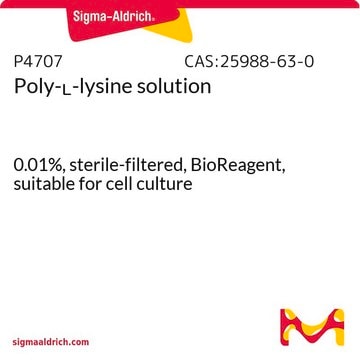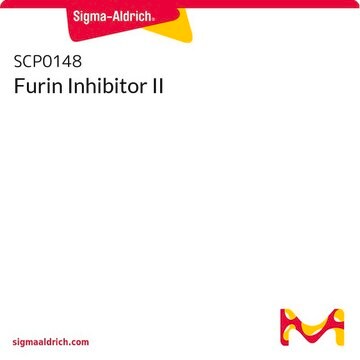Kluczowe dokumenty
P3892
Poly-L-arginine hydrochloride
suitable for bioconjugations, Mol wt >70,000
Synonim(y):
Chlorowodorek homopolimeru L-argininy
About This Item
Polecane produkty
Nazwa produktu
Poly-L-arginine hydrochloride, mol wt >70,000
Formularz
powder or solid
Poziom jakości
masa cząsteczkowa
>70,000
metody
bioconjugation: suitable
kolor
white to off-white
temp. przechowywania
−20°C
ciąg SMILES
Cl.NC(CCCNC(N)=N)C(O)=O
InChI
1S/C18H38N12O4.ClH/c19-10(4-1-7-26-16(20)21)13(31)29-11(5-2-8-27-17(22)23)14(32)30-12(15(33)34)6-3-9-28-18(24)25;/h10-12H,1-9,19H2,(H,29,31)(H,30,32)(H,33,34)(H4,20,21,26)(H4,22,23,27)(H4,24,25,28);1H/t10-,11-,12-;/m0./s1
Klucz InChI
PQEISBBDIRAKGR-LFELFHSZSA-N
Szukasz podobnych produktów? Odwiedź Przewodnik dotyczący porównywania produktów
Powiązane kategorie
Zastosowanie
- as polyelectrolyte solution in the synthesis of biodegradable capsules[1]
- as layer constituent, in the preparation of layer by layer (LbL) assembly of multilayer biodegradable shells[2]
- in assay for the determination of binding activity of C-reactive protein for polycationic ligands[3]
Działania biochem./fizjol.
Jakość
Komentarz do analizy
Inne uwagi
Kod klasy składowania
11 - Combustible Solids
Klasa zagrożenia wodnego (WGK)
WGK 3
Temperatura zapłonu (°F)
Not applicable
Temperatura zapłonu (°C)
Not applicable
Środki ochrony indywidualnej
Eyeshields, Gloves, type N95 (US)
Wybierz jedną z najnowszych wersji:
Certyfikaty analizy (CoA)
Nie widzisz odpowiedniej wersji?
Jeśli potrzebujesz konkretnej wersji, możesz wyszukać konkretny certyfikat według numeru partii lub serii.
Masz już ten produkt?
Dokumenty związane z niedawno zakupionymi produktami zostały zamieszczone w Bibliotece dokumentów.
Klienci oglądali również te produkty
Produkty
Humankind has utilized protein materials throughout its existence, starting with the use of materials such as wool and silk for warmth and protection from the elements and continuing with the use of recombinant DNA techniques to synthesize proteins with unique and useful properties.
Active Filters
Nasz zespół naukowców ma doświadczenie we wszystkich obszarach badań, w tym w naukach przyrodniczych, materiałoznawstwie, syntezie chemicznej, chromatografii, analityce i wielu innych dziedzinach.
Skontaktuj się z zespołem ds. pomocy technicznej











